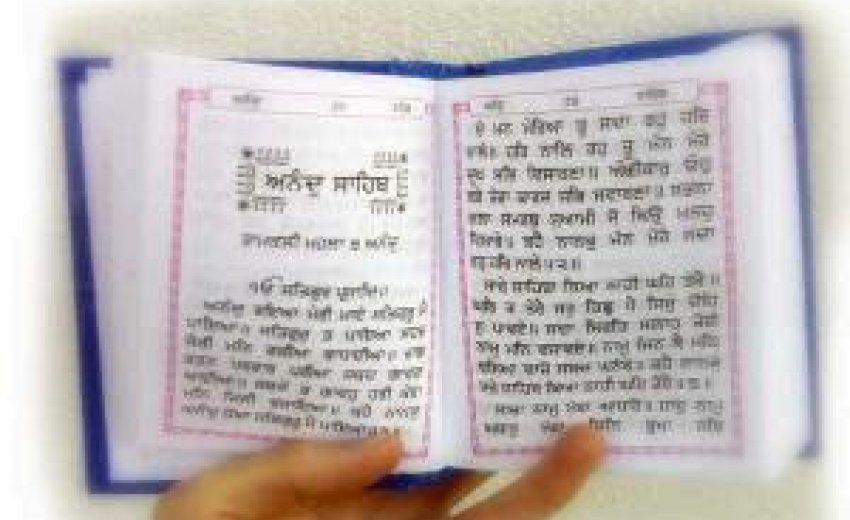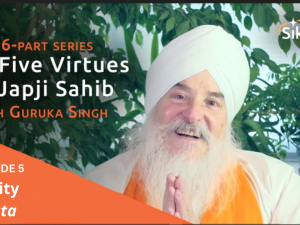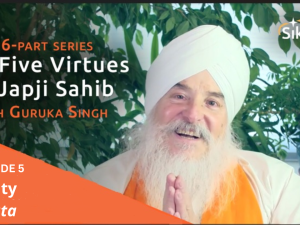Human birth is supreme amongst all life forms as it provides an opportunity for the soul to end its journey of births and deaths and merge in God. For this to occur, a human must realize why he or she has taken this birth and then conduct his or her life accordingly. This is taught by the scriptures which are Sri Guru Granth Sahib and compositions of the tenth Guru of the Sikhs. The compositions are called Banis.
The Sikh Rehit Maryada (Code of Conduct) has indicated the Banis to be recited in the morning, evening and at bedtime (called 'doing Paath'.) They have been so chosen as to facilitate a spiritual householder's life. This means doing our mundane duties but setting aside time to remind ourselves of the purpose of life and the inevitability of death.
The practice of Nitnem facilitates remembering God; and also helps us to break away from mundane activities and thus avoid worldly attachments. This also clarifies the concept of 'avoiding worldly attachments' or Moh frequently advocated in Gurbani.
Guru Nanak explains the need for doing this:
ਜੋ ਦੀਸੈ ਸੋ ਆਸ ਨਿਰਾਸਾ ॥
ਕਾਮ ਕ੍ਰੋਧ ਬਿਖੁ ਭੂਖ ਪਿਆਸਾ ॥
ਨਾਨਕ ਬਿਰਲੇ ਮਿਲਹਿ ਉਦਾਸਾ ॥੮॥ ੧ ੨੨੪
I find every one filled with desires or disappointments:
Every one is in the grip of desires, wrath and craving (for mammon);
Rare ones are those not attached to these (M: 1, p 224).
Gurbani exhorts us to remember God with single minded attention:
ਪ੍ਰਭਕੀ ਉਸਤਤਿ ਕਰਹੁ ਸੰਤ ਮੀਤ ॥ ਸਾਵਧਾਨਏਕਾਗਰ ਚੀਤ ॥ ੫ ੨੯੫
O my holy friends praise God;Do it with alertness and single minded attention (M: 5, p 295).
Doing Paath to praise God is establishing communication with the Divine. If we can perceive the Lord to be present with us it creates a zeal for communication. The third Guru says:
ਸਦਾ ਹਦੂਰਿ ਗੁਰਮੁਖਿ ਜਾਪੈ ॥ ਸਬਦੇ ਸੇਵੈ ਸੋ ਜਨੁ ਧ੍ਰਾਪੈ ॥
ਅਨਦਿਨੁ ਸੇਵਹਿ ਸਚੀ ਬਾਣੀ ਸਬਦਿ ਸਚੈ ਓਮਾਹਾ ਹੇ ॥੮॥ ੩ ੧੦੫੫
God's presence is perceived through the Guru's word:
One who thus serves the Lord feels satisfied;
He then ever dwells on the Word and is enthused (M: 3, p 1055).
If we understand the Shabad and love it, we are enthused to recite or sing it. Without proper understanding Paath remains only mechanical recitation. Guru Nanak explains:
ਜਿਨਿ ਕਹਿਆ ਤਿਨਿ ਕਹਨੁ ਵਖਾਨਿਆ ॥
ਜਿਨਿ ਬੂਝਿਆ ਤਿਨਿ ਸਹਜਿ ਪਛਾਨਿਆ ॥
ਦੇਖਿ ਬੀਚਾਰਿ ਮੇਰਾ ਮਨੁ ਮਾਨਿਆ ॥੬॥ ੧ ੨੨੧
One, who just says, only keeps saying;he who understands, experiences the Lord easily;
this seeing and experiencing is satisfying for the mind (M: 1, p 221).
However there are impediments to concentration resulting in distractions, yawning or even drowsiness. These may be due to one or more of the following factors: Insufficient sleep.
- Rich food.
- Overeating or being famished.
- Making an effort to concentrate.
- Physical fatigue.
- Some strong desire.
- Thoughts of past events or future plans.
- Being in a conflict situation.
It is not easy to control the mind in case of the last two issues listed above, but knowing why we are reciting a Bani and what it means can be helpful in keeping distractions at bay. Conflict situations may be helped by prayer. The tenth Guru prays:
ਨਮੋ ਕਲਹ ਕਰਤਾ ਨਮੋ ਸਾਂਤ ਰੂਪੇ ॥ ਜਾਪ, ੧੮੭
My obeisance is to to One who creates conflict but is the embodiment of peace (Jaap, 187).
Thinking along these lines motivates one to realize if oneself is the cause for the conflict, its continuation or exacerbation.
The method of recitation is important as proper recitation not only gives satisfaction but the entire body and mind participate in the process.
Recitations should be done matching with the breathing rhythm. This helps in the speech, body and mind working in unison. This way the speaker neither gets out of breath as in a fast recitation or by combining sentences (Tuks), or having the mind wander if speaking is too slow.
A devotee who has achieved success in concentration can probably be in a posture for a long time without feeling the strain. The general prescription however is:
ਮਨ ਮੇਰੇਸੁਖ ਸਹਜ ਸੇਤੀ ਜਪਿ ਨਾਉ ॥ ੫ ੪੪
O my mind remember the Divine virtues naturally and comfortably (M: 5, p 44).
Tayra keeta jaato naahi - mainu jog keetoee (Rehras)
Sometimes many breaks may become necessary; they come automatically and in their proper places when the recitation is understood. The reverse is also true; if thus recited the tuk is easily understood. Here are few examples:Tu Karta sachiaar - mainda saaee;
Jau tau bhaavai - soee theesee - jo tu deh - soee hau paee (Rehras).
Kavav so vela - vakhat kavan - kavan thit - kavan vaar;
Kavan se ruti - maah kavan - jit hoaa aakaar (Japji).
Des aur na bhes jaakar - roop - rekh - na raag;
jatr tatr - dis visa - hoe phaileo - anuraag. 80. (Jaap Sahib).
At times when the situation is more adverse, concentration becomes easier if we recite every word deliberately separated from the last. This also helps in understanding the recitation.
The one single factor helpful in achieving concentration is deflation of the self (ego) as when making a spplication. In other words Nitnem should be simply and clearly done in devotion and in humility (Nimrata.)
Understanding of the recitation creates interest and one feels motivated. Going a step further, interest can be further enhanced if it is understood why a particular Bani is usually recited at a given time of day. Understanding the purpose of each individual Bani also helps in being aware of of the recitation.
Although each of the banis in our Nitnem is tuned to the energy of a specific time of day, you must not let anyone else tell you what is "right" and what is "wrong." What matters is what is in your heart, not anyone else's opinion or judgement. Understand the flow of your day as you live it, with your own work and sleep schedule, and recite the banis in the natural rhythm of that day.
Each of the banis carries the energy of a particular tattva (element)
- Ether - Japji Sahib and Shabd Hazaaray (Amrit Vela) Balances your natural earth energy with the etheric energy
-
Air - Jaap Sahib and Tav Prasaad Swayaas (Morning) Tunes your mind to the Power of the Infinite
-
Fire - Anand Sahib (Morning) Energizes and empowers you
-
Water - Rehiras Sahib with Bentee Chaupaee (Sundown) Moves you gracefully from the male sun energy of the day into the female moon energy of the night
-
Earth - Kirtan Sohilaa (bedtime) Prepares you to leave the earth
Japji Sahib
This is in the form of Updesh or instruction to the mind from the soul. It is meant to be recited to the self and is not primarily meant for others to hear, but it can certainly be done in a group as well. If this is kept in mind it should be possible to identify ego or any other distraction. Japji Sahib conditions the mind to be receptive.
Jaap Sahib
This Bani of the tenth Guru is entirely in praise of Akal Purakh either in second or third person. In the former portions, it should be possible to detect whether the speaker is talking to the Master or not. Sometimes negative ideas tend to come to mind during Paath. These pertain to something that has happened or is to be done. If such a thing happens one may tell the self, "so this is how you talk to the Lord?” The course may then be corrected. Of course this is applicable in respect of all Banis.
Swayyay
These ten Swayyas are the last composition before we take on the mundane activities for the day. They tell us not to get too engrossed in making money, unjust exercise of authority and the like. The ninth Swayya tells us to avoid pretense and act in love (Jin prem keeo tin hi Prabh paaio). Understanding them as such makes them relevant and helps in concentration.
Rehras is recited at sunset after the day's work is over. One may be tired, elated or not so happy because of what happened during the day. The compositions forming the parts of Rehras are meant to thank the Lord for enabling us to do our duties that day. It is mostly in second person addressed to God. The day's distraction and fatigue may make concentration difficult but it helps if the mind is motivated that it is going to talk to the Master. Its beginning lends itself well for the purpose. It starts with "Sodar tayra kihaa --". Later "Vaday mayaray Saahiba --", Tu ghat ghat antar --"Tu karta sachiaar maidaa saaee", "Na hau jatti satti nahi --" all in second person. These are only representative examples. Similarly in the Chaupaee the tenth Guru enables us to talk to Akal Purakh in large part e.g. "Hamri karahu haath day rachhaa", "Tumhay chaad koee na dhiaaoo", "Raakh lahu mohay raakhanhaaray" and so on.
Sohila
Sohila which is normally recited at bed time is a short Bani reminding us about the end of life and preparing us to leave the earth. Every time one goes to sleep, it is a “little death,” and so this bani is a “rehearsal” so to speak for the final leaving. If recited in that spirit, it brings humility and concentration followed by good sleep.





